
Persicaria pensylvanica is a species of flowering plant in the buckwheat family, Polygonaceae. It is native to parts of North America, where it is widespread in Canada and the United States. It has also been noted as an introduced species in parts of Europe and South America. Common names include Pennsylvania smartweed and pinkweed.

Sonchus arvensis, the field milk thistle, field sowthistle, perennial sow-thistle, corn sow thistle, dindle, gutweed, swine thistle, or tree sow thistle, is a species of flowering plant in the family Asteraceae. S. arvensis often occurs in annual crop fields and may cause substantial yield losses.

Cirsium discolor, the field thistle, is a North American species of plants in the tribe Cardueae within the family Asteraceae. It is native to thirty-three states in the United States as well four Canadian provinces. It occurs across much of eastern and central Canada as well as eastern and central United States. It has been found from New Brunswick west to Saskatchewan and south as far as Texas and Georgia.

Euchiton sphaericus, the star cudweed or tropical creeping cudweed, is a herb native to Australia, New Zealand, New Caledonia, Taiwan, Java, and Philippines. It has become naturalized in a few places in the United States.
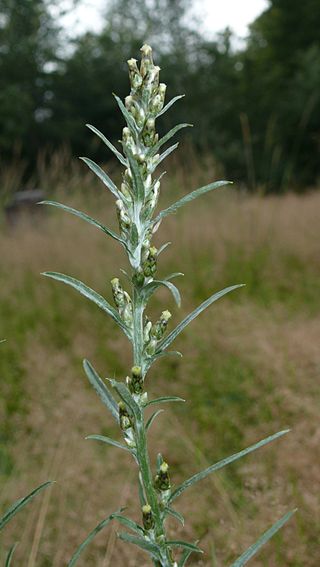
Omalotheca sylvatica, synonyms including Gnaphalium sylvaticum, is a species of plant in the family Asteraceae. It is commonly known as heath cudweed, wood cudweed, golden motherwort, chafeweed, owl's crown, and woodland arctic cudweed. It is widespread across the temperate Northern Hemisphere, throughout North America and Eurasia. The species was first formally described by Carl Linnaeus in 1753 as Gnaphalium sylvaticum.
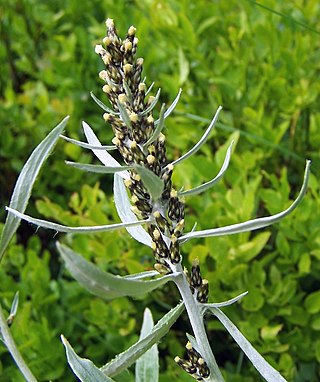
Omalotheca norvegica, synonym Gnaphalium norvegicum, is a European species of plants in the family Asteraceae. It is known as the highland cudweed or Norwegian arctic cudweed. It is native to eastern Canada and Greenland, and widespread across much of Eurasia from the Mediterranean north to Finland and Iceland and east to Siberia.

Gamochaeta is a genus of flowering plants in the family Asteraceae. There has not always been agreement among botanists regarding its status as a recognized genus, but it has become more accepted in recent years. It currently includes many plants that previously belonged in genus Gnaphalium. Like many species of Gnaphalium, many Gamochaeta are called cudweeds or everlastings.
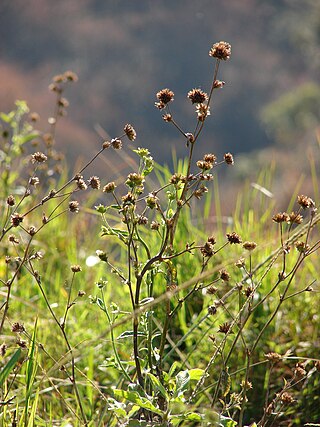
Elephantopus mollis, common names tobacco weed, and soft elephantsfoot, is a tropical species of flowering plant in the family Asteraceae.
Tagetes pusilla, the lesser marigold, is a Latin American species of marigolds in the family Asteraceae. It is native Central America and western South America from Guatemala to northern Argentina.
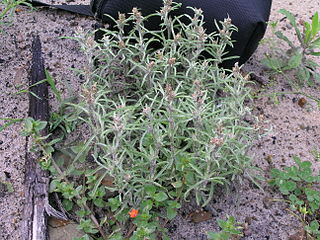
Gamochaeta antillana, the delicate everlasting, is a species of flowering plant in the family Asteraceae. It is native to the Greater Antilles and to the southeastern United States. It has also become naturalized in other places.
Gamochaeta stagnalis, the desert cudweed, is a species of flowering plant in the family Asteraceae. It is native to Mexico, Guatemala, and the southwestern United States.

Gamochaeta calviceps, the narrowleaf purple everlasting, is a species of flowering plant in the family Asteraceae. It is native to South America and to the southeastern United States (from Texas and Oklahoma to Virginia. It has also become naturalized in other places.
Gamochaeta stachydifolia is a species of flowering plant in the family Asteraceae. It is native to South America and naturalized in parts of California.

Gamochaeta coarctata, the gray everlasting, is a species of flowering plant in the family Asteraceae. It is widespread in South America and naturalized in parts of Eurasia, Australia, and North America.
Gamochaeta sphacelata, the owl's crown, is a species of flowering plant in the family Asteraceae. It is widespread across South America, Central America, and Mexico with the distribution just barely crossing the Río Grande into western Texas.
Gamochaeta argyrinea, the silvery cudweed or silvery everlasting, is a North American species of flowering plant in the family Asteraceae. It is widespread across the southeastern and south-central United States from Delaware south to Florida and west as far as southeastern Kansas and central Texas. It has also been found in Puerto Rico and in northern California.
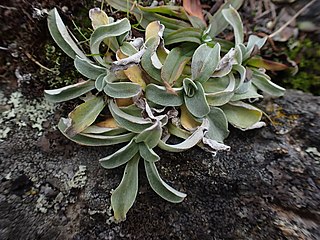
Gamochaeta ustulata, commonly named featherweed or Pacific cudweed, is a North American species of flowering plant in the family Asteraceae. It is native to the western United States and southwestern Canada, in British Columbia, Washington, Oregon, and California. It is found primarily on seaside hills and in the Coast Ranges, with additional populations inland.
Gamochaeta simplicicaulis, the simple-stem cudweed or simple-stem everlasting, is a species of flowering plant in the sunflower family. It is native to South America and has become naturalized in Australia, New Zealand, and the southeastern United States.

Gnaphalium polycaulon, the many stem cudweed, is a plant species in the family Asteraceae. It is widespread across much of Mesoamerica, South America, and the West Indies, and naturalized in parts of Asia and Africa.
Hypochaeris microcephala, the smallhead cat's ear, is a species of plants in the tribe Cichorieae within the family Asteraceae. It is native to South America and naturalized in parts of North America.














